#Exploring the Objects in JavaScript
Explore tagged Tumblr posts
Text
Exploring the Objects in JavaScript BOM: In-Depth Tutorial

As web developers, we are constantly immersed in the world of JavaScript and its various components. Among these, the Browser Object Model (BOM) plays a crucial role in interacting with the browser and enhancing user experience. In this blog post, we will delve into the realm of BOM, understanding its significance, and discovering how Webtutor.dev can be your ultimate resource for mastering this essential aspect of web development.
What is the Browser Object Model (BOM)?
The Browser Object Model (BOM) is a crucial part of JavaScript that provides a bridge between the web browser and the webpage's content, allowing developers to control and manipulate the browser window. Unlike the Document Object Model (DOM), which deals with the structure and content of the webpage, the BOM handles aspects such as the browser history, location, navigator, and more.
The BOM provides a set of objects, properties, and methods that empower developers to interact with the browser and obtain information about the user's environment, enabling the creation of dynamic and responsive web applications.
Understanding the Key Components of BOM
Window Object
The window object is the top-level object representing the browser window or tab. It serves as the global object in the browser environment and provides access to various properties and methods related to the browser window.
Screen Object
The screen object represents the user's screen and provides information about its characteristics, such as the width, height, color depth, and pixel density. With this information, developers can create responsive designs that adapt to different screen sizes and resolutions, offering a seamless user experience across devices.
Navigator Object
The navigator object contains information about the user's browser, such as the name, version, and platform, enabling developers to create browser-specific functionalities and optimizations.
Location Object
The location object represents the current URL of the web page and allows developers to interact with the browser's location bar, enabling navigation to different pages and manipulating the URL.
History Object
The history object provides control over the user's browsing history, enabling developers to navigate forward and backward through the pages the user has visited during the current session.
Timing Events
The timing events are an essential aspect of the BOM that allow developers to execute code at specific intervals or after a certain delay. Functions such as setTimeout() and setInterval() enable developers to schedule code execution, making it possible to create animations, periodic updates, and timed interactions in web applications.
Popup Alerts
One of the simplest yet effective features of the BOM is the ability to display popup alerts. These alerts are often used to deliver important messages, validation errors, or prompts to the user. With just a few lines of JavaScript code, developers can create these popup alerts, enhancing the overall user experience on their websites.
Cookies
The cookies are small pieces of data stored on the user's computer by websites they visit. The BOM provides a way to create, read, and delete cookies, which are often used to store user preferences, authentication tokens, and other information that helps websites deliver personalized experiences to users.
Why Choose Webtutor.dev for Mastering BOM?
Webtutor.dev is your go-to resource for learning and mastering the Browser Object Model and all its intricacies. Here is why it stands out as the perfect platform for developers of all levels:
Comprehensive BOM Tutorials
We offers a comprehensive set of tutorials specifically focused on BOM, covering each aspect in detail with practical examples that reinforce your understanding.
Interactive Coding Exercises
Learning by doing is essential in web development, and we provides an array of interactive coding exercises that challenge and refine your BOM skills.
Real-world Projects
Take your BOM knowledge to the next level by working on real-world projects, guided by experienced instructors, to gain hands-on experience and build your portfolio.
Community Support
Join a vibrant community of developers on our platform, where you can engage in discussions, seek help, and collaborate on projects to enhance your learning journey.
Constantly Updated Content
We ensures that its content is up-to-date with the latest trends and best practices in web development, ensuring you stay relevant in the ever-evolving tech landscape.
Conclusion
The Browser Object Model (BOM) plays a critical role in web development, enabling developers to interact with the browser and create dynamic and engaging web applications. Understanding the various components of BOM is essential for any web developer, and Webtutor.dev offers the perfect platform to master this crucial aspect.
Whether you are a beginner eager to explore the basics or an experienced developer looking to refine your skills, Webtutor.dev provides a wealth of resources, interactive exercises, and real-world projects to support your learning journey. Embrace the power of BOM and unlock your full potential as a web developer with Webtutor.dev today!
#Key Components of BOM#Browser Object Model#Exploring the Objects in JavaScript#Learn javascript online#JavaScript Window#JavaScript Window Object#JavaScript Screen Object#JavaScript Navigator Object#JavaScript Location Object#JavaScript History Object#JavaScript Timing Events#JavaScript Popup Alerts#JavaScript Cookies#Comprehensive BOM Tutorials
1 note
·
View note
Text
I’ve always struggled to define what I do in one word. I draw, I write, I code, I sew. I keep creating because the impulse doesn’t leave me alone.



I really love the word geisha for its etymology. A geisha (芸者) is literally "a person of the arts" — gei (芸) means "art, craft, performance" and sha (者) means "person". In it's core it is not a job, nor a label, it is a way of being. A class.
Before I ought to call myself anything, here’s a shortcut to understanding what you’re dealing with, a list of my skills and interests:
𝕳𝖊𝖑𝖑𝖔 𝖙𝖍𝖊𝖗𝖊, 𝖎’𝖒 𝕶𝖆𝖔𝖒𝖚
✦ Visual Arts – digital and traditional illustration, oil painting, watercolor, character design, comics, mixed media, concept art.
✦ Writing – short stories, scripts, poetry, worldbuilding, narrative design for games and comics, introspective philosophical ramblings that I turn eventually into something else.

✦ Crafts – sewing, embroidery, fabric manipulation, sculpture, DIY repairs, customization of clothes and objects.
✦ Tech & Games – HTML/CSS, a bit of JavaScript, simple game development (mainly card games), game design, automations, layout creation.



https://gothharajuku.itch.io
✦ Audio & Video – video editing, experimental soundtracks, narration, music, video concepts with visuals.
youtube
Silly attempt of studying music production
✦ Mystical & Philosophical – tarot reading, palmistry, hermetic knowledge, lucid dreaming, dreamwork, psychedelic exploration, and ontological curiosity.
**Obviously, I’m better at some of these things than others, and there’s still a lot I can’t do — but probably not for long, I am crazy. There’s this restlessness in my mind (the voices),
in my soul that keeps me in motion:**
✧*。creating, training, learning, thinking. ✧*。
If you like my art, you can support my work just by following me across any platform — kaomunokami anywhere, if you didn't find me, it is because I'm not there. To the wealthbearers of forgotten fortunes, you can also support me through Ko-fi.
Given the proper credit, sharing my art is completely allowed and even encouraged, on any platform.
**You are welcome to DM me to chat about anything, be aware that I am Miss Talkalot. **
𝔻𝕄 𝕒𝕝𝕤𝕠 𝕗𝕠𝕣 𝕥𝕙𝕖 𝕓𝕝𝕒𝕔𝕜 𝕞𝕒𝕣𝕜𝕖𝕥 (𝕒𝕜𝕒 𝕔𝕠𝕞𝕞𝕚𝕤𝕤𝕚𝕠𝕟𝕚𝕟𝕘 𝕞𝕖).
⁺‧₊˚ ཐི⋆♱⋆ཋྀ ˚₊‧⁺
𝒾 𝒽ℴ𝓅ℯ 𝓎ℴ𝓊 𝒶𝓇ℯ 𝒽𝒶𝓋𝒾𝓃ℊ 𝒶 𝓁ℴ𝓋ℯ𝓁𝓎 𝒹𝒶𝓎
⁺‧₊˚ ཐི⋆♱⋆ཋྀ ˚₊‧⁺
4 notes
·
View notes
Text
Audio and Music Application Development

The rise of digital technology has transformed the way we create, consume, and interact with music and audio. Developing audio and music applications requires a blend of creativity, technical skills, and an understanding of audio processing. In this post, we’ll explore the fundamentals of audio application development and the tools available to bring your ideas to life.
What is Audio and Music Application Development?
Audio and music application development involves creating software that allows users to play, record, edit, or manipulate sound. These applications can range from simple music players to complex digital audio workstations (DAWs) and audio editing tools.
Common Use Cases for Audio Applications
Music streaming services (e.g., Spotify, Apple Music)
Audio recording and editing software (e.g., Audacity, GarageBand)
Sound synthesis and production tools (e.g., Ableton Live, FL Studio)
Podcasting and audio broadcasting applications
Interactive audio experiences in games and VR
Popular Programming Languages and Frameworks
C++: Widely used for performance-critical audio applications (e.g., JUCE framework).
JavaScript: For web-based audio applications using the Web Audio API.
Python: Useful for scripting and prototyping audio applications (e.g., Pydub, Librosa).
Swift: For developing audio applications on iOS (e.g., AVFoundation).
Objective-C: Also used for iOS audio applications.
Core Concepts in Audio Development
Digital Audio Basics: Understanding sample rates, bit depth, and audio formats (WAV, MP3, AAC).
Audio Processing: Techniques for filtering, equalization, and effects (reverb, compression).
Signal Flow: The path audio signals take through the system.
Synthesis: Generating sound through algorithms (additive, subtractive, FM synthesis).
Building a Simple Audio Player with JavaScript
Here's a basic example of an audio player using the Web Audio API:<audio id="audioPlayer" controls> <source src="your-audio-file.mp3" type="audio/mpeg"> Your browser does not support the audio element. </audio> <script> const audio = document.getElementById('audioPlayer'); audio.play(); // Play the audio </script>
Essential Libraries and Tools
JUCE: A popular C++ framework for developing audio applications and plugins.
Web Audio API: A powerful API for controlling audio on the web.
Max/MSP: A visual programming language for music and audio.
Pure Data (Pd): An open-source visual programming environment for audio processing.
SuperCollider: A platform for audio synthesis and algorithmic composition.
Best Practices for Audio Development
Optimize audio file sizes for faster loading and performance.
Implement user-friendly controls for audio playback.
Provide visual feedback (e.g., waveforms) to enhance user interaction.
Test your application on multiple devices for audio consistency.
Document your code and maintain a clear structure for scalability.
Conclusion
Developing audio and music applications offers a creative outlet and the chance to build tools that enhance how users experience sound. Whether you're interested in creating a simple audio player, a complex DAW, or an interactive music app, mastering the fundamentals of audio programming will set you on the path to success. Start experimenting, learn from existing tools, and let your passion for sound guide your development journey!
2 notes
·
View notes
Text
JavaScript
Introduction to JavaScript Basics
JavaScript (JS) is one of the core technologies of the web, alongside HTML and CSS. It is a powerful, lightweight, and versatile scripting language that allows developers to create interactive and dynamic content on web pages. Whether you're a beginner or someone brushing up on their knowledge, understanding the basics of JavaScript is essential for modern web development.
What is JavaScript?
JavaScript is a client-side scripting language, meaning it is primarily executed in the user's web browser without needing a server. It's also used as a server-side language through platforms like Node.js. JavaScript enables developers to implement complex features such as real-time updates, interactive forms, and animations.
Key Features of JavaScript
Interactivity: JavaScript adds life to web pages by enabling interactivity, such as buttons, forms, and animations.
Versatility: It works on almost every platform and is compatible with most modern browsers.
Asynchronous Programming: JavaScript handles tasks like fetching data from servers without reloading a web page.
Extensive Libraries and Frameworks: Frameworks like React, Angular, and Vue make it even more powerful.
JavaScript Basics You Should Know
1. Variables
Variables store data that can be used and manipulated later. In JavaScript, there are three ways to declare variables:
var (old way, avoid using in modern JS)
let (block-scoped variable)
const (constant variable that cannot be reassigned)
Example:
javascript
Copy code
let name = "John"; // can be reassigned const age = 25; // cannot be reassigned
2. Data Types
JavaScript supports several data types:
String: Text data (e.g., "Hello, World!")
Number: Numeric values (e.g., 123, 3.14)
Boolean: True or false values (true, false)
Object: Complex data (e.g., { key: "value" })
Array: List of items (e.g., [1, 2, 3])
Undefined: A variable declared but not assigned a value
Null: Intentional absence of value
Example:
javascript
Copy code
let isLoggedIn = true; // Boolean let items = ["Apple", "Banana", "Cherry"]; // Array
3. Functions
Functions are reusable blocks of code that perform a task.
Example:
javascript
Copy code
function greet(name) { return `Hello, ${name}!`; } console.log(greet("Alice")); // Output: Hello, Alice!
4. Control Structures
JavaScript supports conditions and loops to control program flow:
If-Else Statements:
javascript
Copy code
if (age > 18) { console.log("You are an adult."); } else { console.log("You are a minor."); }
Loops:
javascript
Copy code
for (let i = 0; i < 5; i++) { console.log(i); }
5. DOM Manipulation
JavaScript can interact with and modify the Document Object Model (DOM), which represents the structure of a web page.
Example:
javascript
Copy code
document.getElementById("btn").addEventListener("click", () => { alert("Button clicked!"); });
Visit 1
mysite
Conclusion
JavaScript is an essential skill for web developers. By mastering its basics, you can create dynamic and interactive websites that provide an excellent user experience. As you progress, you can explore advanced concepts like asynchronous programming, object-oriented design, and popular JavaScript frameworks. Keep practicing, and you'll unlock the true power of JavaScript!
2 notes
·
View notes
Text

28.11.2023 - Thursday
Ok, trying to get back on track with my blog here, and my studies.
So many things hapenned, guys. I am overwhelmed theses past weeks... let me enumerate them here (I will do it for my goals for December 2023 and the whole 2024 to):
- I was transferred to another team at work (the Engineering Web team), and now I have to deal with a much more profound coding understanding to help other developer teams in the company;
- My father-in-law died in the end of the last week;
- I am reviewing my next steps for my academic life in 2024;
It had been a long time since I'd been in a cemetery, it was strange, sad, and heavy. I just realized that we don't know how much time we have on this Earth, and that we need to do what we must to achieve our goals, dreams, and whatever makes us happy. And, because of that, I am reviewing some life objectives for 2024 and on:
- I going to check some master's degree course for me;
- I am also checking something in the Data or Cybersecurity area to specialize myself (I want to explore something specific in IT);
- I MUST get my IELTS!!!!
- I am managing my husband's Ghost cosplay profile (from Call of Duty), to distract myself and help him - it is fun, I am loving the "Ghost simp fandom";
- There is this life-side project I am delaying, but I will give more attention to it next year too (top-secret);
And of course, tons of coding study (mainly JavaScript, Nest.js, Angular, React - and probably Next.js too, due to the Web team). That's why I am forcing myself to return to the 4 am study people because it is the only time I can focus without any surroundings distraction.
Well, this is it. Some changes, some sadness... but life goes on, and I have to do something for myself and my future, I cannot let myself down!
Have a nice week you all! Miss you and miss here ❤️
#studyblr#study#study blog#daily life#dailymotivation#study motivation#study space#studying#productivity#study desk#coding#programming#girls in programming#life changing#plans for 2024#plans for the future
14 notes
·
View notes
Text
The Roadmap to Full Stack Developer Proficiency: A Comprehensive Guide
Embarking on the journey to becoming a full stack developer is an exhilarating endeavor filled with growth and challenges. Whether you're taking your first steps or seeking to elevate your skills, understanding the path ahead is crucial. In this detailed roadmap, we'll outline the stages of mastering full stack development, exploring essential milestones, competencies, and strategies to guide you through this enriching career journey.

Beginning the Journey: Novice Phase (0-6 Months)
As a novice, you're entering the realm of programming with a fresh perspective and eagerness to learn. This initial phase sets the groundwork for your progression as a full stack developer.
Grasping Programming Fundamentals:
Your journey commences with grasping the foundational elements of programming languages like HTML, CSS, and JavaScript. These are the cornerstone of web development and are essential for crafting dynamic and interactive web applications.
Familiarizing with Basic Data Structures and Algorithms:
To develop proficiency in programming, understanding fundamental data structures such as arrays, objects, and linked lists, along with algorithms like sorting and searching, is imperative. These concepts form the backbone of problem-solving in software development.
Exploring Essential Web Development Concepts:
During this phase, you'll delve into crucial web development concepts like client-server architecture, HTTP protocol, and the Document Object Model (DOM). Acquiring insights into the underlying mechanisms of web applications lays a strong foundation for tackling more intricate projects.
Advancing Forward: Intermediate Stage (6 Months - 2 Years)
As you progress beyond the basics, you'll transition into the intermediate stage, where you'll deepen your understanding and skills across various facets of full stack development.
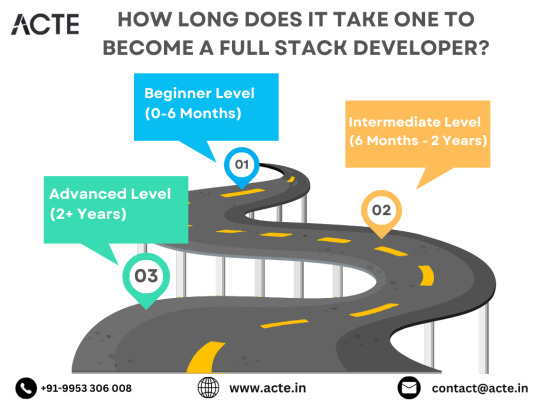
Venturing into Backend Development:
In the intermediate stage, you'll venture into backend development, honing your proficiency in server-side languages like Node.js, Python, or Java. Here, you'll learn to construct robust server-side applications, manage data storage and retrieval, and implement authentication and authorization mechanisms.
Mastering Database Management:
A pivotal aspect of backend development is comprehending databases. You'll delve into relational databases like MySQL and PostgreSQL, as well as NoSQL databases like MongoDB. Proficiency in database management systems and design principles enables the creation of scalable and efficient applications.
Exploring Frontend Frameworks and Libraries:
In addition to backend development, you'll deepen your expertise in frontend technologies. You'll explore prominent frameworks and libraries such as React, Angular, or Vue.js, streamlining the creation of interactive and responsive user interfaces.
Learning Version Control with Git:
Version control is indispensable for collaborative software development. During this phase, you'll familiarize yourself with Git, a distributed version control system, to manage your codebase, track changes, and collaborate effectively with fellow developers.
Achieving Mastery: Advanced Phase (2+ Years)
As you ascend in your journey, you'll enter the advanced phase of full stack development, where you'll refine your skills, tackle intricate challenges, and delve into specialized domains of interest.
Designing Scalable Systems:
In the advanced stage, focus shifts to designing scalable systems capable of managing substantial volumes of traffic and data. You'll explore design patterns, scalability methodologies, and cloud computing platforms like AWS, Azure, or Google Cloud.
Embracing DevOps Practices:
DevOps practices play a pivotal role in contemporary software development. You'll delve into continuous integration and continuous deployment (CI/CD) pipelines, infrastructure as code (IaC), and containerization technologies such as Docker and Kubernetes.
Specializing in Niche Areas:
With experience, you may opt to specialize in specific domains of full stack development, whether it's frontend or backend development, mobile app development, or DevOps. Specialization enables you to deepen your expertise and pursue career avenues aligned with your passions and strengths.
Conclusion:
Becoming a proficient full stack developer is a transformative journey that demands dedication, resilience, and perpetual learning. By following the roadmap outlined in this guide and maintaining a curious and adaptable mindset, you'll navigate the complexities and opportunities inherent in the realm of full stack development. Remember, mastery isn't merely about acquiring technical skills but also about fostering collaboration, embracing innovation, and contributing meaningfully to the ever-evolving landscape of technology.
#full stack developer#education#information#full stack web development#front end development#frameworks#web development#backend#full stack developer course#technology
10 notes
·
View notes
Text
Did You Know the Math Simulation Software GeoGebra? 🎓🧮
In the realm of educational technology, few tools have revolutionized the way we teach and learn mathematics as profoundly as GeoGebra. This dynamic software seamlessly blends geometry, algebra, calculus, and statistics, offering a versatile platform for students and educators alike. Whether you're a teacher aiming to bring mathematical concepts to life or a student looking to explore the depths of math, GeoGebra has something to offer.
What is GeoGebra? 🤔
GeoGebra is an interactive mathematics software designed to make learning and teaching math more engaging and effective. It's a powerful tool that integrates various branches of mathematics into a single platform, providing users with a comprehensive suite of tools to explore mathematical concepts visually and interactively.
Key Features of GeoGebra 🌟
Interactive Geometry: With GeoGebra, you can create constructions and models using points, vectors, segments, lines, polygons, and conic sections. The dynamic nature of these objects allows for real-time manipulation, making abstract concepts tangible and easier to understand.
Algebraic Integration: Directly input equations and coordinates to see their graphical representations. GeoGebra links algebraic and geometric views, helping users see the relationships between different mathematical expressions.
Calculus Tools: Explore derivatives, integrals, and functions with ease. GeoGebra's calculus tools are designed to help users visualize and understand these complex concepts.
Statistics and Probability: Create graphs of statistical data, calculate probabilities, and visualize distributions. These features make it easier to teach and learn statistical concepts.
3D Graphics: GeoGebra’s 3D capabilities allow for the creation and manipulation of three-dimensional graphs and shapes, providing a deeper understanding of spatial relationships.
Spreadsheet View: Handle data efficiently with the integrated spreadsheet functionality. This feature is perfect for visualizing and analyzing large data sets.
Scripting and Custom Tools: Automate tasks and create custom tools using GeoGebra’s scripting language, GGBScript, and JavaScript. This allows for tailored solutions to specific mathematical problems.
Cross-Platform Availability: GeoGebra is accessible as a web application and on various platforms including Windows, macOS, Linux, iOS, and Android, ensuring that you can use it anywhere, anytime.
Transforming Education with GeoGebra 📚💡
GeoGebra is not just a tool for solving mathematical problems; it's a bridge that connects theoretical mathematics with practical understanding. Here’s how it’s making an impact in education:
Visualization: Complex mathematical concepts become accessible through visual representation, making it easier for students to grasp abstract ideas.
Interactive Learning: Students engage more actively with math by manipulating objects and seeing the immediate effects of changes.
Immediate Feedback: GeoGebra provides instant visual feedback, aiding in the learning process and helping students correct mistakes in real-time.
Collaborative Learning: It supports group projects and resource sharing, fostering a collaborative learning environment.
Customizable Resources: Teachers can create interactive worksheets and tailor lessons to meet the needs of their students.
Why Choose GeoGebra? 🤩
User-Friendly Interface: Designed to be intuitive and easy to use, GeoGebra is suitable for all educational levels.
Rich Community and Resources: A large community of users shares resources, tutorials, and tips, making it easier to get the most out of GeoGebra.
Cost-Effective: Free to use, GeoGebra is accessible to a wide audience, ensuring that financial barriers do not hinder learning.
Versatility: Whether you’re in elementary school, university, or working on professional research, GeoGebra has tools to meet your needs.
Real-World Applications 🌍🔍
GeoGebra’s versatility extends beyond the classroom. It’s used in academic research, professional presentations, and even in real-world problem-solving scenarios. Its ability to visualize complex data and mathematical relationships makes it an invaluable tool for a wide range of applications.
Conclusion 🎉
GeoGebra is more than just software; it's a transformative educational tool that brings mathematics to life. By combining visualization, interaction, and immediate feedback, GeoGebra helps students and teachers alike to deepen their understanding of math. Whether you're solving algebraic equations, exploring geometric constructions, or delving into calculus and statistics, GeoGebra is your go-to resource for a richer, more engaging mathematical experience. Embrace the power of GeoGebra and unlock the full potential of mathematics! 🚀🧩
3 notes
·
View notes
Text
The Key Differences Between No Code, Low Code, and Full-Code Development
Introduction
In today's fast-paced digital era, software development has become a cornerstone for businesses striving to innovate and stay competitive.
From simple applications to complex enterprise systems, the approach to building software plays a significant role in project success. No Code, Low Code, and Full-Code platforms dominate the landscape, each addressing diverse skill levels and objectives.
According to recent surveys, over 65% of organizations are adopting No Code or Low Code solutions to reduce time-to-market and development costs. However, traditional Full-Code development continues to thrive for projects demanding scalability and custom features.
Understanding the nuances of these approaches is essential to choosing the right method and team for your project. If you’re looking for the Best Software Developers in Singapore, knowing your needs will help you make a confident choice.
Exploring the Three SolutionsEvery business has unique needs, and there isn’t a one-size-fits-all answer to selecting the right development approach. It’s important to learn about each solution and assess which one aligns with your requirements.
No CodeNo Code platforms are created for individuals without a technical background. They enable users to build applications effortlessly using drag-and-drop features and ready-made templates, without writing any code.
Low CodeLow Code solutions provide a hybrid approach, offering both a visual interface and the ability to add custom code. These platforms are ideal for users with basic coding skills who want to speed up development without building from scratch.
Full-CodeFull-Code development involves constructing applications entirely through programming, providing the highest level of flexibility and control. This method typically uses languages like Python, JavaScript, or Ruby and frameworks such as React or Django.
What’s the Difference?
Now that we’ve covered the basics of No Code, Low Code, and Full-Code platforms, it's time to delve into the key factors that will help you make the best choice for your business. Each factor plays a significant role in determining the most suitable solution for your needs.
If navigating through these factors feels overwhelming, you can always rely on the expertise of the Best Software Development Company in Singapore to guide you through the process and help you select the best approach.
1. Scalability and Long-Term Growth
No Code: Works well for small projects but may become limiting as your business grows or requires additional functionality.
Low Code: Offers better scalability than No Code, making it suitable for businesses that are looking to expand and integrate more systems in the future.
Full Code: The most scalable solution, allowing for the growth of complex features and integrations as your business needs evolve over time.
2. Integration with Existing Systems
No Code: Limited in its ability to integrate with other complex systems, but ideal for standalone applications.
Low Code: Provides better integration capabilities, making it possible to connect with other tools and databases, which is helpful for medium-complexity applications.
Full Code: Best for seamless and custom integration with existing systems, offering full control over how different platforms and services connect.
3. Maintenance and Support
No Code: Maintenance is often easier, with built-in updates and less frequent need for troubleshooting, but it may limit your ability to make significant changes.
Low Code: Requires moderate maintenance, but offers more control over customization and can be adapted as your needs evolve.
Full Code: Requires ongoing maintenance and support, but provides full control over updates, bug fixes, and improvements, ensuring long-term reliability and flexibility.
Whether you choose No Code, Low Code, or Full Code, remember that working with the Best Software Development Company in Singapore can help you navigate these considerations effectively.
Benefits to No Code, Low Code, and Full Code
All these three options of No Code, Low Code, and Full Code come with their own set of advantages. Get an idea of each advantage to ensure they are aligning properly with your company's requirements.
Note: In the creative landscape of coding, a software development company can go beyond the traditional ways and help you with several add-on advantages for your project’s fulfillment.
No Code
Enables fast development without technical skills, making them ideal for simple applications.
Perfect platform for small businesses which is affordable ideal for subscription model.
With ease of use, you can easily make changes and build applications quickly.
Low Code:
Low Code platforms offer balance between speed and flexibility.
Enables faster development while allowing for some custom coding.
Perfect for users with basic coding knowledge and can be used for moderately complex applications, with integration capabilities to existing systems.
Full-Code:
Offers maximum flexibility and control for large-scale applications.
It ensures scalability and performance optimization, with complete ownership over the codebase.
Highly adaptable platform which allows advanced functionality as the needs for application grow.
When to Choose the Right Approach
As highlighted earlier, your final decision should align with your business needs. To help you make an informed choice, here are some scenarios outlining which solution works best for different cases:
No Code: Ideal for quickly building simple apps or websites, especially for startups or small-scale projects. A software company in Singapore can assist in implementing your No Code project efficiently. It’s a cost-effective approach that enables fast deployment without requiring coding expertise.
Low Code: Suitable for those with moderate technical knowledge, this option strikes a balance between speed and customization. It allows the creation of more complex applications with the flexibility to integrate seamlessly with other tools and systems.
Full Code: The go-to choice when your project demands advanced features or intricate functionalities beyond the scope of No Code or Low Code. This method ensures complete control over the codebase, making it ideal for large-scale or highly specialized projects requiring scalability and long-term flexibility.
Conclusion
To conclude, the choice between No Code, Low Code, and Full Code ultimately hinges on the scope of your project, available resources, and your long-term objectives.
No Code is perfect for straightforward, budget-friendly solutions that don’t require deep technical expertise.
Low Code strikes a balance by offering more flexibility, making it an excellent option for businesses that need some level of customization without the complexity of Full Code.
On the other hand, Full Code provides unmatched flexibility and scalability, making it the ideal choice for businesses with more intricate and growth-focused projects.
For organizations seeking tailored solutions, collaborating with experienced software developers in Singapore will ensure you receive expert guidance and develop a solution that aligns perfectly with your specific requirements and future growth plans.
1 note
·
View note
Text
Certainly! Let’s explore how to build a full-stack application using Node.js. In this comprehensive guide, we’ll cover the essential components and steps involved in creating a full-stack web application.
Building a Full-Stack Application with Node.js, Express, and MongoDB
1. Node.js: The Backbone of Our Application
Node.js is a runtime environment that allows us to run JavaScript on the server-side.
It’s built on Chrome’s V8 JavaScript engine and uses an event-driven, non-blocking I/O model, making it lightweight and efficient.
Node.js serves as the backbone of our application, providing the environment in which our server-side code will run.
2. Express.js: Simplifying Server-Side Development
Express.js is a minimal and flexible Node.js web application framework.
It provides a robust set of features for building web and mobile applications.
With Express.js, we can:
Set up middlewares to respond to HTTP requests.
Define routing rules.
Add additional features like template engines.
3. MongoDB: Storing Our Data
MongoDB is a document-oriented database program.
It uses JSON-like documents with optional schemas and is known for its flexibility and scalability.
We’ll use MongoDB to store our application’s data in an accessible and writable format.
Building Our Full-Stack Application: A Step-by-Step Guide
Setting Up the Environment:
Install Node.js:sudo apt install nodejs
Initialize a new Node.js project:mkdir myapp && cd myapp npm init -y
Install Express.js:npm install express
Creating the Server:
Create a basic Express server:const express = require('express'); const app = express(); const port = 3000; app.get('/', (req, res) => { res.send('Hello World!'); }); app.listen(port, () => { console.log(`Server running at http://localhost:${port}`); });
Defining Routes:
Define routes for different parts of our application:app.get('/user', (req, res) => { res.send('User Page'); });
Connecting to MongoDB:
Use Mongoose (a MongoDB object modeling tool) to connect to MongoDB and handle data storage.
Remember, this is just the beginning! Full-stack development involves frontend (client-side) work as well. You can use React, Angular, or other frontend libraries to build the user interface and connect it to your backend (Node.js and Express).
Feel free to explore more about each component and dive deeper into building your full-stack application! 😊 12
2 notes
·
View notes
Text
java full stack
A Java Full Stack Developer is proficient in both front-end and back-end development, using Java for server-side (backend) programming. Here's a comprehensive guide to becoming a Java Full Stack Developer:
1. Core Java
Fundamentals: Object-Oriented Programming, Data Types, Variables, Arrays, Operators, Control Statements.
Advanced Topics: Exception Handling, Collections Framework, Streams, Lambda Expressions, Multithreading.
2. Front-End Development
HTML: Structure of web pages, Semantic HTML.
CSS: Styling, Flexbox, Grid, Responsive Design.
JavaScript: ES6+, DOM Manipulation, Fetch API, Event Handling.
Frameworks/Libraries:
React: Components, State, Props, Hooks, Context API, Router.
Angular: Modules, Components, Services, Directives, Dependency Injection.
Vue.js: Directives, Components, Vue Router, Vuex for state management.
3. Back-End Development
Java Frameworks:
Spring: Core, Boot, MVC, Data JPA, Security, Rest.
Hibernate: ORM (Object-Relational Mapping) framework.
Building REST APIs: Using Spring Boot to build scalable and maintainable REST APIs.
4. Database Management
SQL Databases: MySQL, PostgreSQL (CRUD operations, Joins, Indexing).
NoSQL Databases: MongoDB (CRUD operations, Aggregation).
5. Version Control/Git
Basic Git commands: clone, pull, push, commit, branch, merge.
Platforms: GitHub, GitLab, Bitbucket.
6. Build Tools
Maven: Dependency management, Project building.
Gradle: Advanced build tool with Groovy-based DSL.
7. Testing
Unit Testing: JUnit, Mockito.
Integration Testing: Using Spring Test.
8. DevOps (Optional but beneficial)
Containerization: Docker (Creating, managing containers).
CI/CD: Jenkins, GitHub Actions.
Cloud Services: AWS, Azure (Basics of deployment).
9. Soft Skills
Problem-Solving: Algorithms and Data Structures.
Communication: Working in teams, Agile/Scrum methodologies.
Project Management: Basic understanding of managing projects and tasks.
Learning Path
Start with Core Java: Master the basics before moving to advanced concepts.
Learn Front-End Basics: HTML, CSS, JavaScript.
Move to Frameworks: Choose one front-end framework (React/Angular/Vue.js).
Back-End Development: Dive into Spring and Hibernate.
Database Knowledge: Learn both SQL and NoSQL databases.
Version Control: Get comfortable with Git.
Testing and DevOps: Understand the basics of testing and deployment.
Resources
Books:
Effective Java by Joshua Bloch.
Java: The Complete Reference by Herbert Schildt.
Head First Java by Kathy Sierra & Bert Bates.
Online Courses:
Coursera, Udemy, Pluralsight (Java, Spring, React/Angular/Vue.js).
FreeCodeCamp, Codecademy (HTML, CSS, JavaScript).
Documentation:
Official documentation for Java, Spring, React, Angular, and Vue.js.
Community and Practice
GitHub: Explore open-source projects.
Stack Overflow: Participate in discussions and problem-solving.
Coding Challenges: LeetCode, HackerRank, CodeWars for practice.
By mastering these areas, you'll be well-equipped to handle the diverse responsibilities of a Java Full Stack Developer.
visit https://www.izeoninnovative.com/izeon/
2 notes
·
View notes
Text
Exploring the Difference Between Web Development and App Development
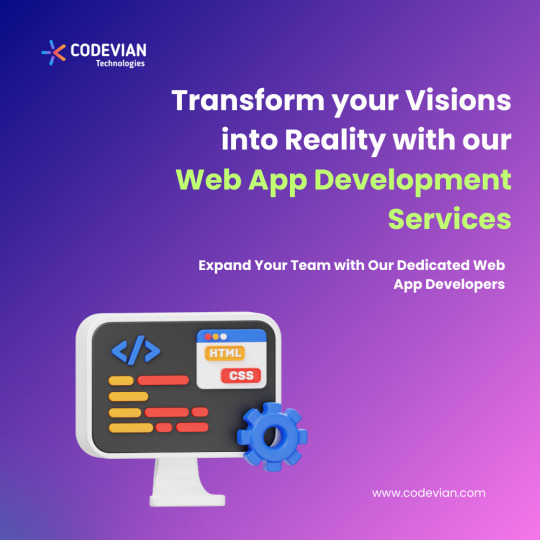
Hey there, tech enthusiasts! So, you've heard about web development and app development, but you're not quite sure what sets them apart? Don't worry, I'll break it down for you in simple terms!
First things first, what exactly is web development? Well, think of it like building a house on the internet! Web development involves creating websites or web applications that can be accessed through a web browser, like Google Chrome or Safari. It's all about designing, building, and maintaining websites that people can visit and interact with online.
Now, let's talk about app development. This is like building a cozy little home on your smartphone or tablet! App development involves creating mobile applications that are installed directly onto your device, like games, social media apps, or productivity tools. It's all about designing, building, and maintaining applications that people can download and use on their mobile devices.
So, what's the difference between web development and app development? Here are a few key distinctions:
Platform: The biggest difference between web development and app development is the platform they're built for. Web app development services focuses on creating websites or web applications that are accessed through a web browser on desktop computers or mobile devices. App development, on the other hand, focuses on creating mobile applications that are installed directly onto a device and accessed through an icon on the home screen.
Technology: Web development typically involves technologies like HTML, CSS, and JavaScript for creating the front end (what users see and interact with) and languages like PHP, Python, or Node.js for creating the back end (the server-side logic). App development, on the other hand, often involves languages like Java or Kotlin for Android development, Swift or Objective-C for iOS development, or frameworks like React Native or Flutter for cross-platform development.
Distribution: Web applications are usually accessible to anyone with an internet connection and can be accessed through a web browser without the need for installation. Mobile applications, on the other hand, need to be downloaded and installed onto a device from an app store like the Apple App Store or Google Play Store.
User Experience: The user experience of web applications and mobile applications can be quite different. Web applications are designed to work across different devices and screen sizes, so they often have a responsive design that adapts to fit the user's device. Mobile applications, on the other hand, are specifically designed for use on mobile devices and can take advantage of features like touch screens, GPS, and push notifications.
In conclusion, while web development and app development share some similarities, such as creating digital experiences for users, they also have key differences in terms of platform, technology, distribution, and user experience. Whether you're interested in building websites or mobile applications, both fields offer exciting opportunities to unleash your creativity and make an impact in the digital world!
2 notes
·
View notes
Text
Unleashing the Potential of Selenium Automation: An In-Depth Exploration
Introduction: In the dynamic realm of software development, efficiency and reliability are non-negotiable. With the proliferation of web applications, the demand for robust testing solutions has reached new heights. Enter Selenium – a versatile open-source test automation framework that has transformed the landscape of software testing. In this comprehensive exploration, we'll delve into the multitude of advantages offered by Selenium automation and delve deeper into why it has become the preferred choice for testers and developers worldwide.

1. Seamless Cross-Browser Compatibility: Selenium automation stands out for its seamless cross-browser compatibility feature. Testers can effortlessly execute tests across various web browsers such as Chrome, Firefox, Safari, and Edge. This ensures uniform performance across different platforms, minimizing compatibility issues and enhancing user experience.
2. Platform Flexibility and Independence: A standout feature of Selenium automation is its platform flexibility and independence. Tests crafted with Selenium can be run on diverse operating systems including Windows, macOS, and Linux. This versatility empowers teams to conduct testing on their preferred platforms, fostering collaboration and efficiency.
3. Multilingual Support for Enhanced Productivity: Selenium offers support for multiple programming languages including Java, Python, C#, and JavaScript. This multilingual support enables testers to write automation scripts in their language of choice, maximizing productivity and leveraging existing programming expertise.
4. Promoting Reusability and Ease of Maintenance: Selenium promotes code reusability and ease of maintenance through modular test design and adoption of design patterns like the Page Object Model (POM). By breaking down tests into smaller, reusable components, testers can streamline maintenance efforts and enhance scalability.
5. Accelerating Regression Testing Processes: Automation with Selenium significantly accelerates regression testing, allowing testers to detect and rectify bugs early in the development cycle. Seamless integration with continuous integration (CI) pipelines enables automatic execution of test suites, ensuring software stability and quality.
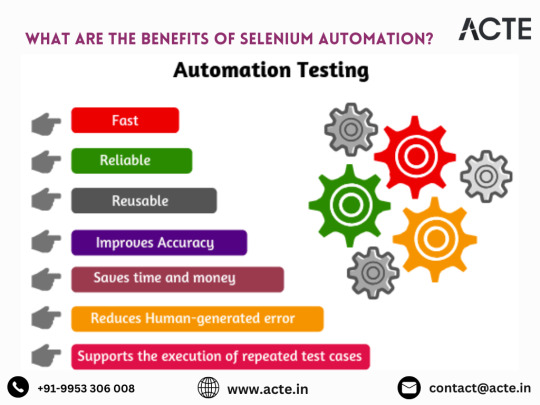
6. Comprehensive Test Coverage for Robust Applications: Selenium enables testers to achieve comprehensive test coverage by automating repetitive scenarios, edge cases, and boundary conditions. This meticulous testing ensures thorough validation of application functionality and user interactions, resulting in more robust software products.
7. Scalability and Parallel Execution Efficiency: Selenium facilitates parallel execution of tests across multiple browsers and environments, enabling teams to scale automation efforts effectively. By distributing test execution across different machines or virtual environments, testers can expedite the testing process and achieve faster feedback cycles.
8. Streamlined Integration with CI/CD Pipelines: Seamless integration with continuous integration/continuous deployment (CI/CD) pipelines enables automated testing as an integral part of the software delivery process. Automated build verification tests (BVTs) and regression tests ensure software stability, facilitating faster and more frequent deployments.
Conclusion: In conclusion, Selenium automation offers a plethora of advantages that empower testers to streamline testing efforts, enhance software quality, and expedite the development lifecycle. From cross-browser compatibility and platform independence to scalability and CI/CD pipeline integration, Selenium has redefined software testing in the modern era. By harnessing the power of Selenium, organizations can achieve faster releases, superior software quality, and heightened customer satisfaction, gaining a competitive edge in the ever-evolving digital landscape.
2 notes
·
View notes
Text
Mastering Fullstack Development: Unifying Frontend and Backend Proficiency
Navigating the dynamic realm of web development necessitates a multifaceted skill set. Enter the realm of fullstack development – a domain where expertise in both frontend and backend intricacies converge seamlessly. In this comprehensive exploration, we'll unravel the intricacies of mastering fullstack development, uncovering the diverse responsibilities, essential skills, and integration strategies that define this pivotal role.
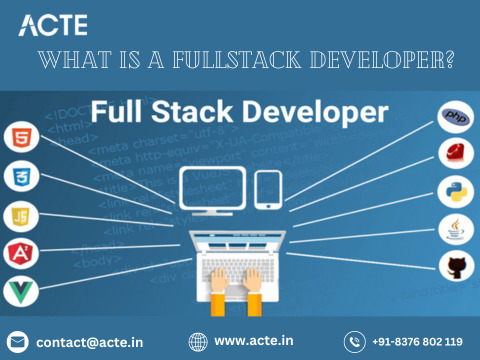
Exploring the Essence of Fullstack Development:
Defining the Role:
Fullstack development epitomizes the fusion of frontend and backend competencies. Fullstack developers are adept at navigating the entire spectrum of web application development, from crafting immersive user interfaces to architecting robust server-side logic and databases.
Unraveling Responsibilities:
Fullstack developers shoulder a dual mandate:
Frontend Proficiency: They meticulously craft captivating user experiences through adept utilization of HTML, CSS, and JavaScript. Leveraging frameworks like React.js, Angular.js, or Vue.js, they breathe life into static interfaces, fostering interactivity and engagement.
Backend Mastery: In the backend realm, fullstack developers orchestrate server-side operations using a diverse array of languages such as JavaScript (Node.js), Python (Django, Flask), Ruby (Ruby on Rails), or Java (Spring Boot). They adeptly handle data management, authentication mechanisms, and business logic, ensuring the seamless functioning of web applications.
Essential Competencies for Fullstack Excellence:
Frontend Prowess:
Frontend proficiency demands a nuanced skill set:
Fundamental Languages: Mastery in HTML, CSS, and JavaScript forms the cornerstone of frontend prowess, enabling the creation of visually appealing interfaces.
Framework Fluency: Familiarity with frontend frameworks like React.js, Angular.js, or Vue.js empowers developers to architect scalable and responsive web solutions.
Design Sensibilities: An understanding of UI/UX principles ensures the delivery of intuitive and aesthetically pleasing user experiences.
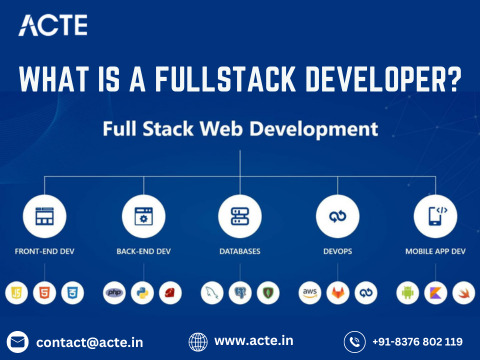
Backend Acumen:
Backend proficiency necessitates a robust skill set:
Language Mastery: Proficiency in backend languages such as JavaScript (Node.js), Python (Django, Flask), Ruby (Ruby on Rails), or Java (Spring Boot) is paramount for implementing server-side logic.
Database Dexterity: Fullstack developers wield expertise in database management systems like MySQL, MongoDB, or PostgreSQL, facilitating seamless data storage and retrieval.
Architectural Insight: A comprehension of server architecture and scalability principles underpins the development of robust backend solutions, ensuring optimal performance under varying workloads.
Integration Strategies for Seamless Development:
Harmonizing Databases:
Integrating databases necessitates a strategic approach:
ORM Adoption: Object-Relational Mappers (ORMs) such as Sequelize for Node.js or SQLAlchemy for Python streamline database interactions, abstracting away low-level complexities.
Data Modeling Expertise: Fullstack developers meticulously design database schemas, mirroring the application's data structure and relationships to optimize performance and scalability.
Project Management Paradigms:
End-to-End Execution:
Fullstack developers are adept at steering projects from inception to fruition:
Task Prioritization: They adeptly prioritize tasks based on project requirements and timelines, ensuring the timely delivery of high-quality solutions.
Collaborative Dynamics: Effective communication and collaboration with frontend and backend teams foster synergy and innovation, driving project success.
In essence, mastering fullstack development epitomizes a harmonious blend of frontend finesse and backend mastery, encapsulating the versatility and adaptability essential for thriving in the ever-evolving landscape of web development. As technology continues to evolve, the significance of fullstack developers will remain unparalleled, driving innovation and shaping the digital frontier. Whether embarking on a fullstack journey or harnessing the expertise of fullstack professionals, embracing the ethos of unification and proficiency is paramount for unlocking the full potential of web development endeavors.
#full stack developer#full stack course#full stack training#full stack web development#full stack software developer
2 notes
·
View notes
Text
Top Frontend Development Tools to Use in 2023
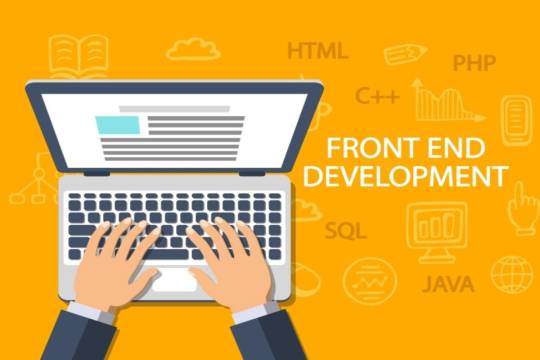
Front-End Web Development is a rapidly evolving field, with new tools and technologies constantly emerging. As we step into the year 2023, front-end developers are facing new challenges and opportunities in crafting engaging and responsive user interfaces. To stay ahead in this dynamic landscape, it's crucial to arm yourself with the right Frontend Development Tool.
In this blog, we will explore the top front-end development tools that are expected to dominate the industry in 2023. From code editors and frameworks to design tools and performance optimization, these tools will help you streamline your workflow, enhance productivity, and create cutting-edge web applications that meet the demands of modern users. Let's dive into the exciting world of front-end development and discover the must-have tools for 2023!
Top Frontend Development Tools to Use in 2023:
ReactJS:
ReactJS is a popular JavaScript library used by any Frontend Development Company for building user interfaces. With its component-based architecture, React allows developers to create reusable UI components that can be easily combined to build complex web applications.
React's virtual DOM (Document Object Model) enables efficient rendering, making it highly performant for creating interactive and dynamic user interfaces. React also has a large ecosystem of supporting tools, libraries, and community resources, making it a top choice for front-end development in 2023.
Vue.js:
Vue.js is another powerful JavaScript framework for building user interfaces. Known for its simplicity and ease of integration, Vue.js offers a flexible and scalable approach to front-end development. Vue.js follows a component-based architecture similar to React, making it highly modular and easy to understand.
Vue.js also offers features like two-way data binding, computed properties, and a comprehensive template syntax that simplifies the development process. With its growing popularity and extensive documentation, Vue.js is expected to gain more traction with any Web Development Company in 2023.
Figma:
Figma is a popular design tool that has gained significant popularity in recent years. It offers a collaborative and cloud-based approach to design, allowing front-end developers to work seamlessly with designers.
Figma offers powerful design and prototyping features, such as vector editing, component libraries, and real-time collaboration, making it a go-to tool for designing modern and responsive user interfaces. Figma also offers integrations with other design and development tools, making it a versatile choice for front-end developers in 2023.
Visual Studio Code:
Visual Studio Code (VSCode) is a widely used code editor that has become a staple in the front-end development community. With its extensive plugin ecosystem, powerful debugging capabilities, and rich set of features, VSCode provides an efficient and productive environment for writing front-end code.
VSCode offers support for a wide range of programming languages, including JavaScript, HTML, CSS, and popular front-end frameworks, making it a top choice for front-end developers in 2023.
Performance Optimization Tools:
As web applications become more complex, optimizing performance has become a crucial aspect of front-end development. Tools like Lighthouse, Webpage Test, and Google Page Speed Insights help developers analyze and optimize the performance of their web applications.
These tools offer insights and recommendations for improving areas like load times, caching, image optimization, and accessibility, helping developers create blazing-fast and user-friendly web applications in 2023.
jQuery:
jQuery is a widely used JavaScript library that has been a popular front-end development tool for many years. It provides a simplified way to interact with HTML documents, manipulate DOM elements, handle events, and make AJAX requests. jQuery offers a concise syntax and cross-browser compatibility, making it easy for developers to write efficient and interactive front-end code.
One of the key advantages of using jQuery is its simplicity and ease of use. It provides a concise and intuitive syntax that allows developers to perform common tasks, such as traversing the DOM, manipulating elements, and handling events, with just a few lines of code. This can significantly reduce the amount of code needed and simplify the development process.
Git and Version Control Tools:
Version control is an essential aspect of modern front-end development, allowing developers to collaborate, track changes, and revert to previous versions of their code.
Git, along with platforms like GitHub and GitLab, offers powerful version control capabilities, making it easy to manage the codebase, collaborate with teammates, and deploy changes to production. These tools are expected to continue to be a critical part of front-end development workflows in 2023.
CSS Pre-processors:
CSS pre-processors like Sass, Less, and Stylus have become popular tools for writing efficient and maintainable CSS code. These pre-processors offer features like variables, mixins, and nested selectors, making it easier to manage and organize CSS code for large web applications.
Conclusion:
The top front-end development tools for 2023 are expected to provide developers with powerful features that enhance their productivity, streamline their workflow, and enable them to create modern, responsive, and high-performing user interfaces.
These tools will be invaluable for Frontend Development Company India and Frontend developers in keeping up with the evolving landscape of web development. If you are looking for a Frontend Development Company in India, then connect with us now.
3 notes
·
View notes
Text
Importance of MERN Stack
What is MERN Stack?
Four essential technologies make up the full-stack JavaScript framework MERN Stack:
MongoDB: A NoSQL database system known for its flexibility and scalability, MongoDB stores data in a JSON-like format, making it ideal for handling large volumes of data.
Express.js: A minimalist web application framework for Node.js, Express.js simplifies the process of building robust and scalable web applications by providing a set of features for web and mobile applications.
React.js: Developed by Facebook, React.js is a powerful JavaScript library for building interactive user interfaces. Its component-based architecture allows developers to create reusable UI components, resulting in a more modular and maintainable codebase.
Node.js: A server-side JavaScript runtime environment, Node.js enables developers to build fast and scalable network applications. With its event-driven, non-blocking I/O model, Node.js is well-suited for building real-time web applications.
Why Choose MERN Stack?
Streamlined Development: With MERN Stack, developers can leverage the power of JavaScript across the entire development stack, from frontend to backend. This unified approach reduces development time and eliminates the need to switch between different programming languages and frameworks.
SEO-Friendly Architecture: MERN Stack's server-side rendering capabilities, coupled with its support for modern JavaScript frameworks like React.js, make it highly SEO-friendly. This ensures that web applications built with MERN Stack are easily discoverable by search engines, leading to improved search engine rankings and increased organic traffic.
Optimized Performance: MERN Stack's asynchronous, non-blocking architecture allows for seamless communication between frontend, backend, and database components, resulting in faster response times and improved performance. This translates to a smoother user experience and higher customer satisfaction.
Improved Security: In today's digital environment, security is of the highest priority. MERN Stack provides built-in security features, such as authentication and authorization mechanisms, as well as support for encryption and data validation, to ensure that web applications are protected against common security threats.
Scalability and Flexibility: Whether you're building a small-scale application or a large-scale enterprise solution, MERN Stack offers the scalability and flexibility you need to grow and adapt to changing business requirements. With its modular architecture and support for microservices, MERN Stack allows for easy scaling and maintenance of complex applications.
Getting Started with MERN Stack
Are you prepared to explore the MERN Stack world? Here is a detailed how-to for getting started:
Install Node.js: Begin by installing Node.js, which includes npm (Node Package Manager), on your local machine. Node.js will serve as the runtime environment for your server-side code.
Set Up MongoDB: Install MongoDB, a NoSQL database system, and set up a local or remote MongoDB instance to store your application data.
Create an Express.js Server: Use Express.js to create a server-side application that will handle HTTP requests and serve as the backend for your web application.
Build Your React.js Frontend: Use React.js to create a client-side application that will handle user interface interactions and communicate with the backend server.
Integrate MongoDB with Express.js: Connect your Express.js server to your MongoDB database using Mongoose, a MongoDB object modeling tool for Node.js.
Deploy Your Application: Once your application is complete, deploy it to a hosting provider of your choice to make it accessible to users worldwide.
Conclusion
MERN Stack offers a powerful and versatile framework for building modern web applications that are fast, scalable, and secure. Whether you're a seasoned developer or just getting started, MERN Stack provides the tools and resources you need to bring your ideas to life. So why wait? Start exploring the endless possibilities of MERN Stack today and unlock the potential of your web development projects with Meander Training, Meander training is a platform where you can start your web development journey, it provides industrial training with certification.
1 note
·
View note
Text
My Perspective on Distinguishing Between Full Stack Developers and Web Developers
I can’t help but go back to my own experience as a web developer as I sit down to write about the difference between full stack developers and web developers. This subject has a special meaning to me since it captures the essence of navigating this fast-paced industry. In order to better appreciate the contrasts between these two jobs, let’s set out on a voyage, and I’ll share my viewpoint and experiences along the way.
We frequently mix the terms “full stack developer” and “web developer” while discussing web development. They stand for several jobs, each with their own set of tasks and abilities. Whether you’re an experienced developer, a newcomer in the industry, or someone pursuing a career in technology, it’s vital to comprehend these contrasts.
Defining Full Stack Developers and Web Developers
Developers who work on the complete stack: Let’s start by defining a full stack developer. In terms of web development, a full stack developer is essentially a jack of all crafts. Both front-end and back-end technologies are familiar to them. This implies that they are capable of managing databases and server-side functionality in addition to designing the user interface. They are essentially the Swiss Army tools of web development.
Web Developers: known as front-end developers — concentrate mostly on the client side of web development. They are masters in using HTML, CSS, and JavaScript to create stunning and engaging user interfaces. Their main objective is to provide a smooth and visually pleasing user experience on a website.
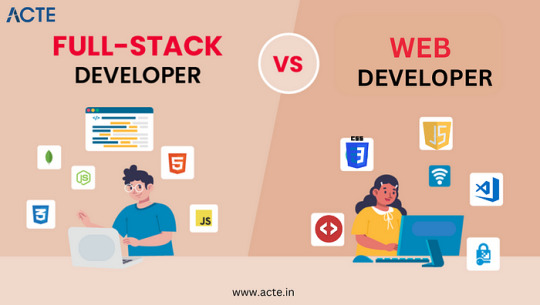
I had a basic comprehension of these jobs when I first started working as a web developer. Like many novices, I mistakenly believed that web programming was solely about producing visually stunning websites. But I quickly understood there was much more to it.
Common Ground: Overlapping Skills
It’s important to acknowledge the areas of overlap between web developers and full stack developers before we get into their distinctions. A solid foundation in front-end development is necessary for both professions. HTML, CSS, and JavaScript proficiency are essential. These languages are your building blocks whether you’re creating a user interface or incorporating sophisticated capabilities.
These front-end abilities were the start of my adventure. I devoted endless hours to polishing my HTML structures, honing my CSS stylesheets, and exploring JavaScript’s potential as an interactive language. These abilities laid the foundation for my profession and are still crucial today.
Delving into Full Stack Development
Let’s now explore full stack development, where the distinctions are more apparent. In addition to being experts in front-end technologies, full stack developers are also knowledgeable in back-end technologies. This covers database management as well as server-side programming languages like Python, Ruby, or Node.js.
Making the switch to back-end development was a turning point for me. Working with databases and server logic first made me feel uneasy. I took the challenge, though, and began studying server-side languages and databases. Even if things weren’t always easy, every challenge I overcame helped me become a better developer.
Web Development: Focusing on the Front End
Web developers, on the other hand, focus on the front end. Their area of expertise is designing captivating, engaging user interfaces. They take great care in website design, making sure that it is aesthetically pleasing, responsive, and user-friendly.
I still clearly recall my first front-end-focused web programming project. Making an interactive and practical design come to life was thrilling. Web developers enjoy the particular high of witnessing a beautifully designed website in use.
Bridging the Gap: The Versatility of Full Stack Developers
The capacity to integrate front-end and back-end development is one of the defining traits of full stack engineers. This adaptability is revolutionary in the tech sector. Full stack developers are able to handle all aspects of development, taking a project from inception to conclusion.
Being a full stack developer has provided me with access to a variety of projects. I’ve had the honor of working on anything from data-driven applications to e-commerce websites. This versatility has improved my skill set and given me the ability to take on a variety of difficulties.
My Personal Journey
I can’t help but thank the mentors, classes, and resources that have molded my perspective as I consider my career as a developer. Participating in coding groups, taking full stack developer courses provided by ACTE Institute, and learning from seasoned developers have all been extremely beneficial to my development.
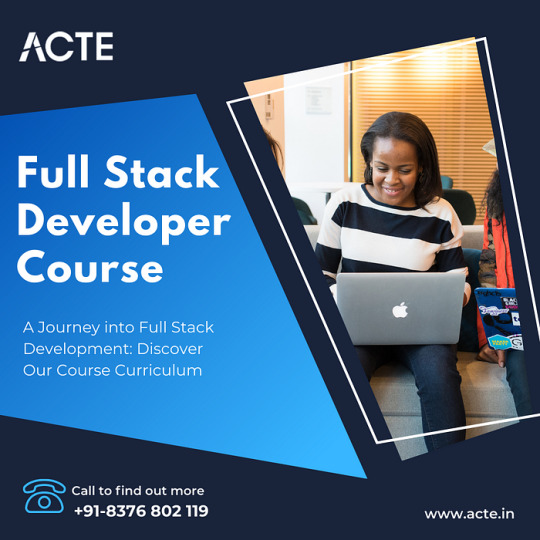
Realizing that no one becomes a full stack developer or web developer over night is essential. It is a path of ongoing learning and development. And keep in mind that each person’s journey is distinctive, formed by their experiences and decisions.
The Ever-Changing Tech Landscape
The only thing that is consistent in the tech sector is change. Both web developers and full stack developers need to keep up with the latest trends and technology. Adaptability is essential, from the emergence of new programming languages to the development of front-end frameworks.
I’ve seen firsthand how quickly tools and techniques for web development have advanced. In this always changing sector, adapting to change and remaining curious have been essential.
In conclusion, anyone navigating the IT sector needs to be aware of the differences between full stack engineers and web developers. Each role has its own advantages and difficulties. Remember that your path as a developer is an ongoing discovery whether you decide to focus on one or embrace the variety of the other.
#full stack developer#web development#full stack web development#frameworks#education#information#technology#front end development#back end#javascript
2 notes
·
View notes